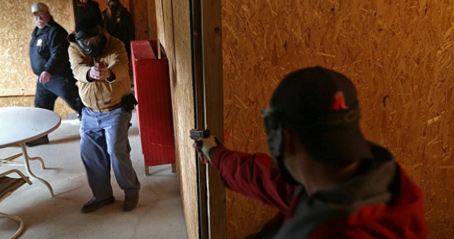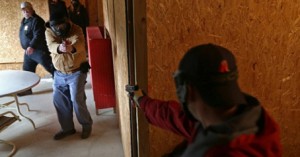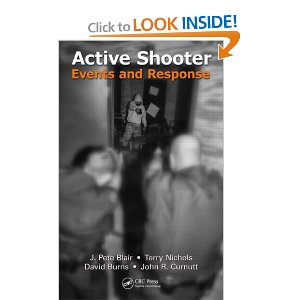Written by: Greg Ellifritz
Force Science Research Institute regularly sends out excellent research-based newsletters. They post the newsletters on their site, but usually are several issues behind. I highly recommend that you subscribe to their newsletter so that you can get the latest updates.
Last week’s newsletter included an interview with the author of a new report and book on active shooter events (as distinguished from “active killer” events because he only researched shootings). The author researched all of the active shooting events that met his criteria over a ten-year period in the United States. His sample included 84 different incidents and his study seems to be very well done with thorough analysis.
His statistics vary somewhat from those of my friend Ron Borsch. The difference is primarily the result of each researcher using differing criteria when selecting incidents to add to their respective databases. There aren’t any absolute truths here, but both data sets are very useful.
I took the italicized prose below from the recent Force Science newsletter. That represents the highlights of the new report and what I think is most useful for anyone who might have to respond to an active shooter event. The bold text is my commentary on the issues presented.
I. Solo officer risks & other truths about active shooter responses
Although total numbers are small, an analysis of active shooter events for the first time has estimated the statistical risk that a single officer assumes when entering a killing site alone in pursuit of a murderous suspect.
“[T]here is a 14% chance that an officer will be shot when he or she makes a solo entry into an active shooter attack site,” according to a report issued recently by a research-and-training team from Texas State University’s School of Criminal Justice. “This makes solo officer entry an extremely dangerous activity.”
Indeed, a single-officer response may make an active shooting “the most dangerous call in law enforcement,” associate professor Dr. J. Pete Blair told Force Science News.
In a study he headed, researchers were able to document 14 instances in which an arriving officer entered an attack site alone. In two cases, the officer ended up being shot before the incident was resolved.
“That is not to say that officers should not make solo entry,” Blair explains. “It’s hard to wait outside and listen to gunshots. A solo entry may be fully justifiable as the best option for saving lives. But we feel that officers should be informed of the risk and not make entry with the expectation that they’re not going to have to fight.”
I truly believe that solo entries are the best tactic for law enforcement to use. Yes, it is dangerous. Any type of gunfight is dangerous. But that’s why the public pays our salaries. Someone has to do the “dangerous” thing. He lists the percentages of officers shot in solo entries, but the newsletter doesn’t contrast that with the percentage of officers shot when responding to active shooters as a two or three person team (no active shooters have ever been stopped by a law enforcement team of more than three people).
Presumably the percentage of officers shot is lower in the multiple officer entry. My contention isn’t that this statistic means multiple officer entry is safer, in all likelihood it is not. My guess is that it takes significantly longer time to round up a “posse” of multiple officers. That additional time gives the shooter more time to either escape, get overpowered by victims, or kill himself. Dead or overpowered suspects don’t shoot officers at the same rate as those who are still armed and ambulatory.
What he documented, Blair believes, is essential for police trainers to know as they work to develop meaningful instruction for their officers. Here are the findings he believes are “most relevant”:
• LOCATION. Active shooter events (ASEs) were most likely (37%) to erupt in a business setting (factory, warehouse, office, retail outlet), followed closely by schools (34%). About 17% occurred outdoors in “public venues.” About 20% of attackers went mobile, either walking or driving to a different location to continue their attack.
In nearly 40% of cases, the shooters had no apparent relationship to the shooting locations(s).
The author’s criteria for entry include any event where the suspect is killing or attempting to kill multiple people. That means two or more people were shot (at). 30 of the author’s 84 events resulted in two or fewer people being actually shot. When we look at shootings where more people were shot we will see that the locations are very different from the ones reported above.
I think the most telling statistic here is the number of shooters who “go mobile”. This is the latest trend and I predict that it will be seen even more in the future. Unfortunately, most police departments aren’t training to deal with this possibility.
• SHOOTER PROFILE. To be counted as an ASE in Blair’s research, an incident had to involve “one or more persons engaged in killing or attempting to kill multiple people in an area occupied by multiple unrelated individuals,” with the primary motive appearing to be mass murder. “At least one of the victims [had to] be unrelated to the shooter.” He excluded gang-related attacks.
Shooters fitting his criteria overwhelmingly proved to be male (92%) and most often were between the ages of 21 and 50, although ones as young as 13 and as old as 88 were encountered.
While all shootings studied involved “some planning,” only 35% of shooters engaged in “extensive planning,” that is, preparation beyond just acquiring weapons and ammunition. This included “obtaining or drawing diagrams of the attack location, possessing a ‘hit list,’ wearing body armor, or acquiring the equipment/supplies needed to trap victims in the location or slow law enforcement response,…preparing a manifesto, blogging about the attack, or developing a media kit.”
• WEAPONRY. “A pistol was the most powerful weapon used in the majority” (60%) of ASEs, Blair states. “Rifles were the next most popular weapon,” deployed in 27% of attacks. In about 40% of cases, shooters carried multiple weapons. Only 2% brought explosives to the attack location.
Very few (4%) tried to protect themselves by wearing body armor.
These results don’t really echo what we have seen in the recent shootings with higher numbers of casualties (Aurora, Sandy Hook, Norway, Mumbai). The shooters who are more successful DO conduct detailed planning and generally use long guns. The use of explosives in these mass casualty (more than four deaths) is actually increasing.
Officers and citizens preparing for an active shooter event shouldn’t be lulled into a sense of safety because of these statistics. Remember, many of these events were workplace violence incidents with very few victims.
• CRITICAL TIMES. The median law enforcement response time after the initial report of an ASE during Blair’s study period was three minutes. The median time from first report to the event ending was also three minutes. By nine minutes, the vast majority of assailants (73%) have stopped shooting. Where events last longer, it generally is because the suspect stopped shooting but barricaded himself or fled the scene.
In the longest instance, police arrived on scene four minutes after being notified. “A SWAT team performed entry 18 minutes later,” Blair notes. “The shooter was then barricaded for approximately seven hours,” until a SWAT operator ended the standoff.
Please understand that response time only reflects how long it took for police to arrive to the incident. It doesn’t take into account the time waiting for backup, loading up with additional equipment, making entry, and finding the shooter. All of that can very easily triple that three-minute response time. If you are a victim in one of these shootings, please understand that the police won’t likely be saving you in 3-4 minutes. It will likely take much more time than the author states before the suspect is either apprehended or killed.
• FORCEFUL RESOLUTION. In 43% of the time, Blair found, the shooting had ended before LEOs arrived. In about half of those incidents, the suspect killed himself. About 4% of the time, he fled. In the remaining cases, people on the scene subdued or shot the shooter.
Once LEOs were on scene, shooters still active were twice as likely to commit suicide as to surrender. Of those whose slaughtering was stopped by police, nearly 70% were shot, the rest physically subdued.
Very similar results to what Ron Borsch published.
In a paper summarizing his study, prepared for the Police Executive Research Forum (PERF), Blair cites the following implications for training from his findings:
• Considering that roughly one in five ASEs occurs outdoors and/or goes mobile, it’s critical for trainers to “address operating in outdoor environments. Movement techniques and other strategies that work indoors in CQB situations may be ineffective–even fatal–in outdoor environments, Blair cautions.
• “While it is true that many active shooters will kill themselves either before the police arrive or when the attacker becomes aware that the police are on scene, the shooter aggressively fights the responding police officers in many cases,” Blair states. “Officers must be trained in tactics that will allow them to defeat the shooter should it become necessary.”
• While IEDs are uncommon, they have been encountered in ASEs. “Officers should receive at least awareness-level training” regarding identification and response to explosive threats.
• Officers should be taught basic mechanical and manual breaching skills, to foil attackers who have barricaded doors and/or windows to prevent police entry. Among other equipment, they should be familiarized with “a variety of shotgun breaching rounds” that can facilitate entry while protecting innocent parties who may be on the other side of the breach point.
• “Officers should be trained to deliver immediate lifesaving care”–with tourniquets and/or wound-care kits, for example–“that can stabilize victims” found at the shooting scene “until higher levels of care can be provided.” This becomes especially important when EMS personnel “will not enter an unsecured scene.” [Editor’s note: For a report on how one law enforcement agency has worked successfully with EMS to better tend to medical emergencies at active shooter scenes see Force Science News #231 sent 06/02/13.]
• Both outdoors and indoors, confrontations may happen “at distances beyond which most officers can effectively engage threats with a pistol,” including large open areas outside and long hallways inside schools and businesses. Patrol rifles are “far more accurate” at much longer distances than pistols, Blair points out. Moreover, with a substantial percentage of active shooters wielding rifles, “at the very least we should place officers on an equal footing with their adversaries.”
• With attackers often willing to fight officers and often carrying weapons that will penetrate standard soft body armor, “there is a need to upgrade the defensive capabilities of responding officers” with a plate carrier for enhanced protection. “If we are going to ask officers to go into attack scenes and confront armed gunmen, we owe it to [them] to give them the best possible chance to survive and win the encounter,” Blair says.
All very important points and I thank the author for highlighting them. If you are an armed citizen, do you have these skills? If half of all active killers are stopped by civilians (as distinguished from police), armed citizens need this type of training as well. If you think merely having a .380 auto in your back pocket prepares you to prevail in a challenging active killer scenario, you are delusional.
“At a bare minimum,” Blair advises, officers should have the knowledge, skills, and abilities needed to deal with a basic attack. If agencies “want their people to be prepared adequately,” they should also address the challenges involved in moderately complex events. Although no highly complex ASE has yet occurred in the US, the book explores the training required for confronting that threat as well, anticipating that that day is coming.
At whatever level, it’s important that training incorporate SWAT-type tactics that have been specially adapted for successful patrol-officer application, Blair says. With the occurrence rate of ASEs apparently accelerating and law enforcement response times improving, it seems inevitable that street officers will increasingly be expected to deal with active shooters as first responders, either alone initially or in small groups.
This may be just semantics, but I disagree somewhat with the author’s statements. One of the huge hurdles in police training is the teaching of SWAT-style tactics to patrol officers. SWAT officers operate in a team environment, generally face multiple suspects in hardened locations, and often get far more training than the average patrol officer.
In contrast, the patrol officer generally works alone or with a partner, arresting single suspects. He isn’t likely to receive any training in team tactics and most are barely proficient with their duty handgun, let alone anything else. There just isn’t enough training time to devote to teaching SWAT tactics. Teaching line officers to be SWAT operators in a single day (which is more time than most departments devote to active shooter training) is a recipe for disaster. I’ve never seen it work out well.
Think about the average active shooter event. It will be one or two officers responding to a lone gunman who has not barricaded himself. Police officers handle calls like that every day! Responding to the most common active shooter events has absolutely no similarity to conducting a SWAT raid! It is more similar to a patrol task. So why do we need to teach specialized SWAT tactics? I believe training time would be better spent training patrol officers to slightly alter their standard building search tactics in response to the changes that the demands of an active shooter event create. Our officers don’t get enough training time as it is, let’s not make things even more complex. Build on the skills that the officers already have, don’t teach something new and complicated!
I’ve included the authors’ entire research report below. While I don’t agree with all of the recommendations it contains, I believe it makes for a very good read and I suggest that anyone interested in the topic should take the time to check it out.
The book Active Shooter Events and Response is available on Amazon.com. I’ve ordered the complete book and will write an article if I find useful information to share.
If you want to see more articles like this, please sign up for my email updates. No spam. Ever. You get an email whenever I post a new article. That’s it.




